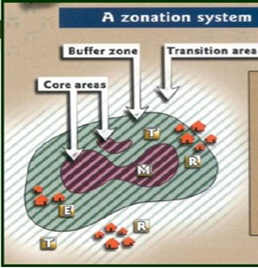With the help of a labeled diagram, describe the basic design of a Biosphere Reserve.
The biosphere reserves are traditionally organized into three interrelated zones, known as the core area, the buffer zone, and a transition zone or ‘area of cooperation.’

Core area: includes protected areas, as they act as reference points on the natural state of the ecosystems represented by the biosphere reserves. Information from these core areas may assess the sustainability of activities, or the maintenance of environmental quality, in surrounding areas.
Buffer zone: surrounds or is contiguous to the core area. Activities are organized so they do not hinder the conservation objectives of the core area, but rather help to protect it. The buffer zone might be an area for experimental research, or may involve ways to manage natural vegetation, agricultural land, forests, fisheries or ranchland to enhance overall quality of production while conserving natural processes and biodiversity.
Transition Zone, or Area of Cooperation: the large outer area of a reserve where people live and work, using the natural resources of the area in a sustainable manner. The term ‘area of cooperation’ underscores the role of cooperation as the main tool to achieve the objectives of the biosphere reserve. It is here that the local communities, conservation agencies, scientists, civil associations, cultural groups, businesses and other stakeholders agree to work together to manage and use the area in a sustainable way that will benefit the people who live there.